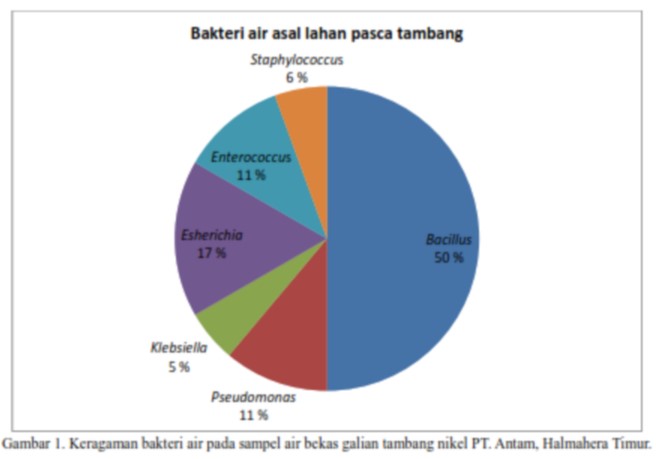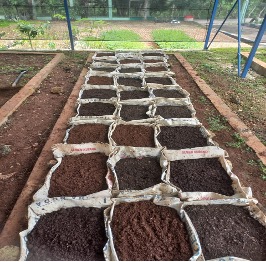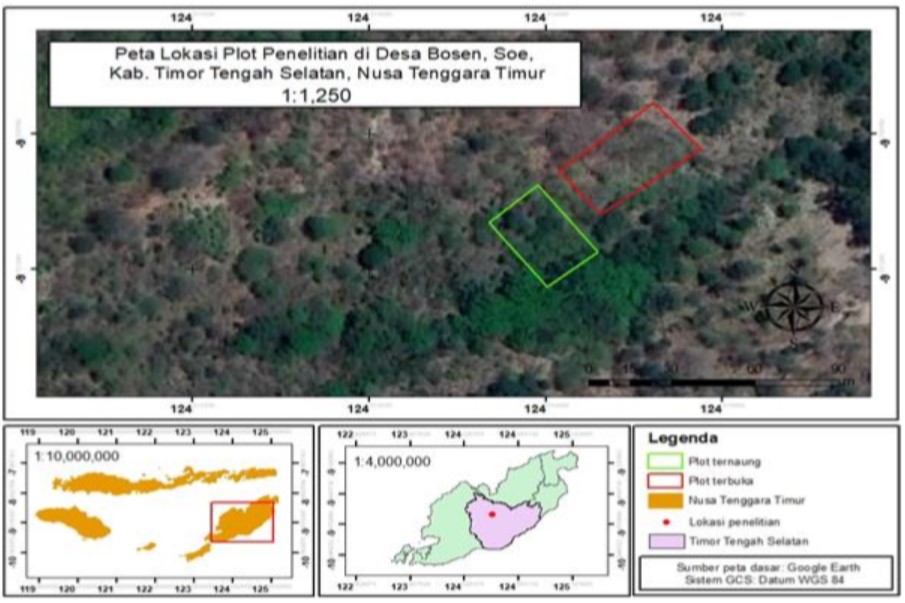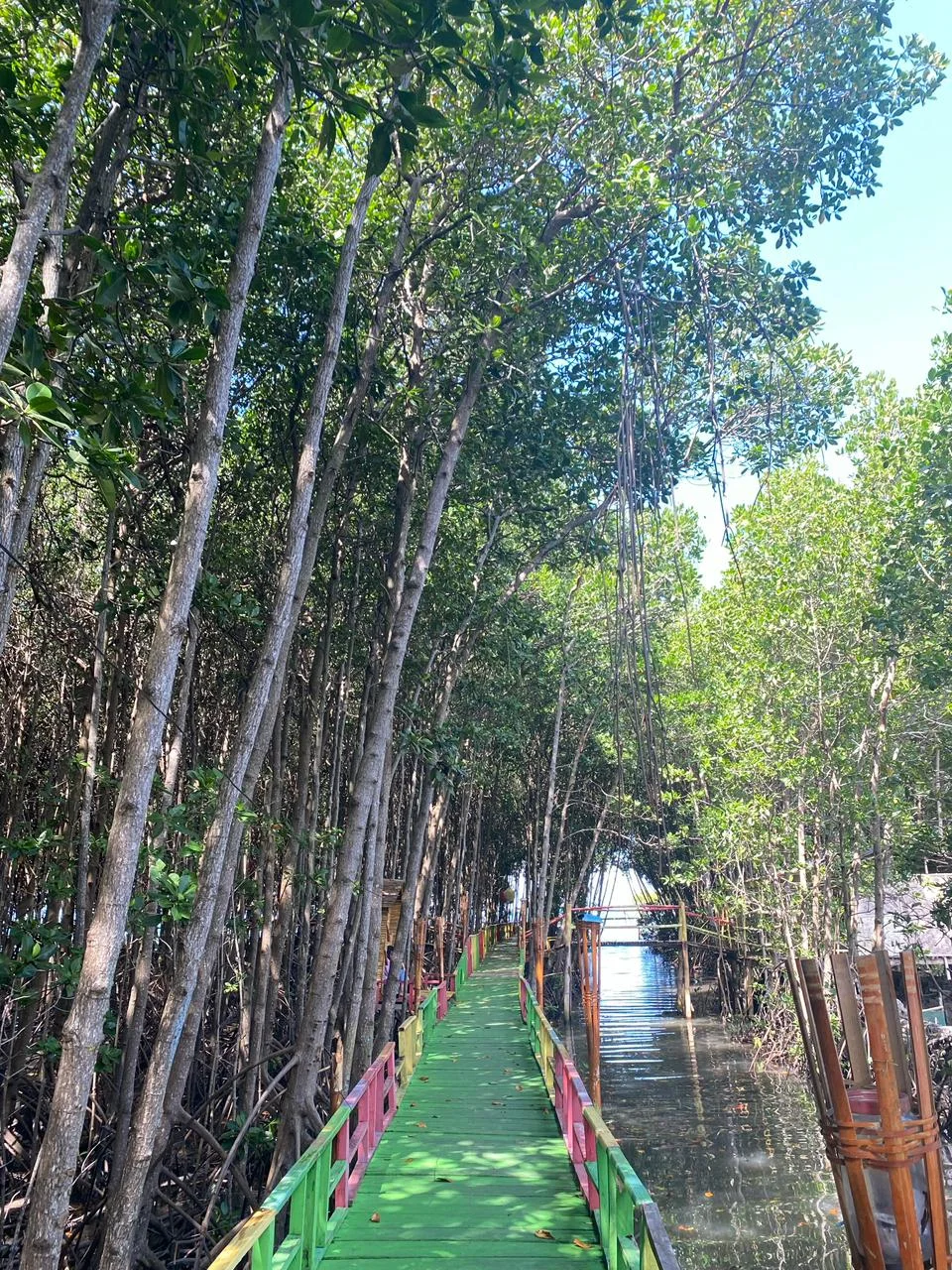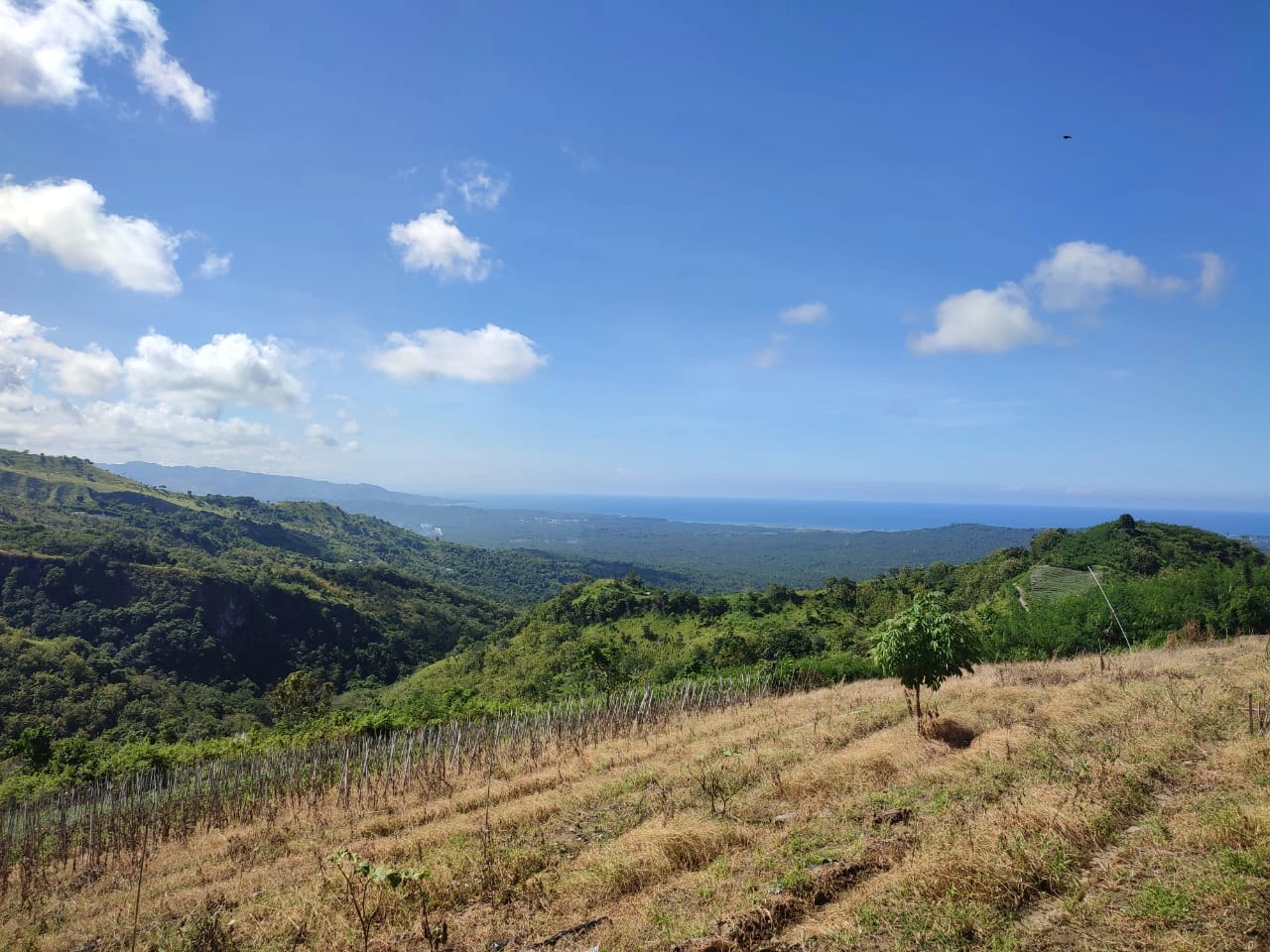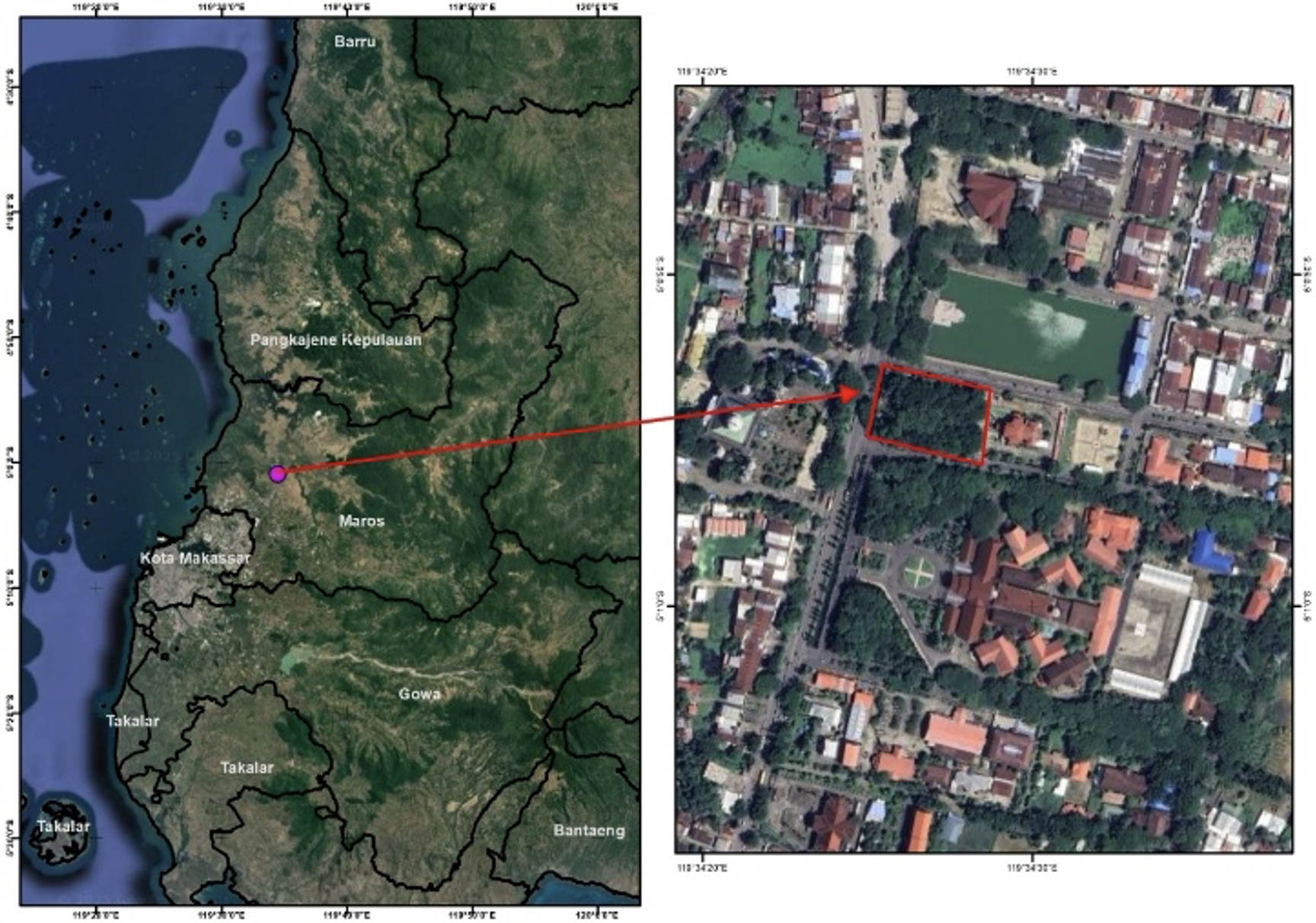Identification of Water Bacteria from Nickel Post Mining in East Halmahera
Abstract
Nickel mining impact in heavy metal pollution on both soil and water. A method that is widely applied to reduce heavy metal contamination is bioremediation. Selection of bacteria that have potential reduction of heavy metal contamination in soil is very important in bioremediation process. The first step to select the potential bacteria is identification of samples. The purpose of this study is to identify existings bacteria in pond after nickel mining area PT. Antam, East Halmahera. Methods used in this research are isolation and identification of bacteria by conventional methods includes morphological, physiologica,l and biochemical test. Identification using Bergey’s Manual Determinative. The results showed there are 6 genera types of bacteria there are Bacillus, Esherichia, Enterococcus, Pseudomonas, Staphylococcus, dan Klebsiella, with 18 species in water of nickel post mining. Morphologically it is dominated by genus Bacillus as 50 % of the species. The identification of bacteria proved an existence of indigenous bacteria which is resistant to heavy metal stress.
Copyright (c) 2018 Jurnal Wasian

This work is licensed under a Creative Commons Attribution-NonCommercial 4.0 International License.
Copyright and License
All articles published in Wasian Journal are the property of the authors. By submitting an article to Wasian Journal, authors agree to the following terms:
-
Copyright Ownership: The author(s) retain copyright and full publishing rights without restrictions. Authors grant the journal the right to publish the work first and to distribute it as open access under a Creative Commons Attribution 4.0 International License (CC BY 4.0).
-
Licensing: Articles published in Wasian Journal are licensed under a Creative Commons Attribution 4.0 International License (CC BY 4.0). This license allows others to share, copy, and redistribute the material in any medium or format, and adapt, remix, transform, and build upon the material for any purpose, even commercially, provided that proper credit is given to the original author(s) and the source of the material

This work is licensed under a Creative Commons Attribution 4.0 International License. -
Author's Rights: Authors are permitted and encouraged to post their work online (e.g., in institutional repositories or on their website) prior to and during the submission process, as it can lead to productive exchanges and greater citation of published work.
-
Third-Party Content: If your article contains material (e.g., images, tables, or figures) for which you do not hold copyright, you must obtain permission from the copyright holder to use the material in your article. This permission must include the right for you to grant the journal the rights described above.
-
Reprints and Distribution: Authors have the right to distribute the final published version of their work (e.g., post it to an institutional repository or publish it in a book), provided that the original publication in Wasian Journal is acknowledged.
For the reader you are free to:
- Share — copy and redistribute the material in any medium or format for any purpose, even commercially.
- Adapt — remix, transform, and build upon the material for any purpose, even commercially.
- The licensor cannot revoke these freedoms as long as you follow the license terms.
Under the following terms:
- Attribution — You must give appropriate credit , provide a link to the license, and indicate if changes were made . You may do so in any reasonable manner, but not in any way that suggests the licensor endorses you or your use.
- No additional restrictions — You may not apply legal terms or technological measures that legally restrict others from doing anything the license permits.
Notices:
You do not have to comply with the license for elements of the material in the public domain or where your use is permitted by an applicable exception or limitation .
No warranties are given. The license may not give you all of the permissions necessary for your intended use. For example, other rights such as publicity, privacy, or moral rightsmay limit how you use the material.
Most read articles by the same author(s)
- Anita Mayasari, Margaretta Christita, Ady Suryawan, The Diversity of Macroscopic Fungi Species of The Wallacea in The Arboretum of BP2LHK Manado , Jurnal Wasian: Vol. 5 No. 2 (2018): December
- Diah Irawati Dwi Arini, Julianus Kinho, Melkianus S Diwi, Margareta Christita, Jafred E Halawane, Muhammad F Fahmi, Yermias Kafiar, Wildlife Diversity for Ecotourism at Aqua Lestari Forest Park, North Minahasa , Jurnal Wasian: Vol. 5 No. 1 (2018): June
- Arif Irawan, Illa Anggraeni Anggraeni, Margaretta Christita, Identification Causes Leaf Spot Disease in Cempaka (Magnolia elegans (Blume.) H.Keng) Seedling and Its Control Techniques , Jurnal Wasian: Vol. 2 No. 2 (2015): December
- Diah Irawati Dwi Arini, Yermias Kafiar, Prefered Feed of Anoa (Bubalus sp.) at Manado Forestry Research Institute Captivity , Jurnal Wasian: Vol. 1 No. 2 (2014): December
- Arif Irawan, Iwanuddin Iwanuddin, Jafred Elsjoni Halawane, Fuad Muhammad, Effect of Fruit Maturity and Extraction Treatment on Germination Percentage of Langusei (Ficus minahassae (Teysm.et.Vr.) Miq)) , Jurnal Wasian: Vol. 7 No. 2 (2020): December
- Supratman Tabba, Lis Nurrani, Distribution of Avifauna in Aketajawe Lolobata National Park Based on Zone and Land Cover Typology , Jurnal Wasian: Vol. 3 No. 1 (2016): June
- Nurlita Indah Wahyuni, Yermias Kafiar, Species Composition and Structure of Secondary Forest at Nunuka, North Bolaang Mongondow , Jurnal Wasian: Vol. 4 No. 1 (2017): June
- Ady Suryawan, Margaretta Christita, Endro Subiandono, Survival Rate, Growth and Seedling Quality Index of Baringtonia Asiatica Kurz Stump Due to Length Variation of Stems and Roots , Jurnal Wasian: Vol. 3 No. 2 (2016): December
- Margaretta Christita, Ady Suryawan, The Effectiveness of Papaya Leaves and Chili Pepper (Capsium fructescens) as Bioinsecticide for White Oyster Mushroom (Pleuroutus ostreatus) Cultivation , Jurnal Wasian: Vol. 5 No. 2 (2018): December
- Arif Irawan, Iwanuddin Iwanuddin, Effectivity of Using Growth Retardants on Shorea assamica Dyer Seedling at Nursery , Jurnal Wasian: Vol. 2 No. 1 (2015): March

